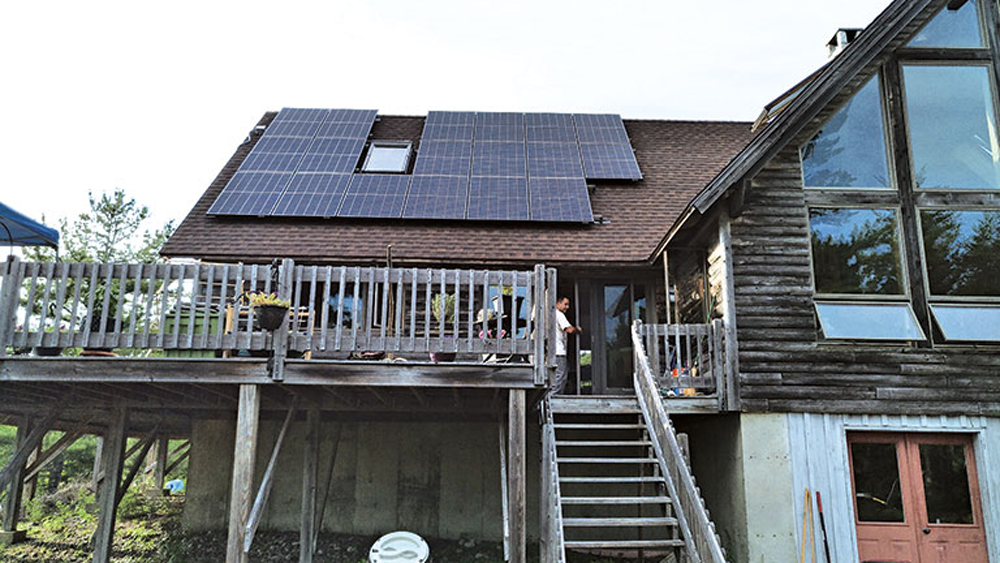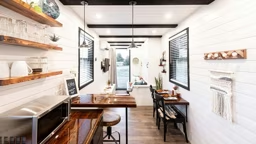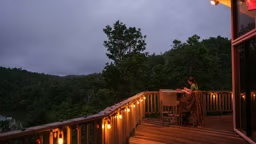
When you want to connect your cabin to the power grid and the local utility tells you that will cost you $130,000, that’s a strong incentive to look at alternatives. That cost estimate is what pushed Jerry and Victoria Wolford to go solar in early 2017. Their 1,900 square-foot cabin in Sullivan, Maine, sits at the tip of Long Pond amid 110 acres of private land purchased by the Wolfords in Frenchman Bay Conservancy.
“We knew we wanted to do solar,” Jerry says. “Running a generator all the time is not a feasible option – with the cost of propane and keeping up with the maintenance,” not to mention the noise.
Going solar for your cabin – whether off-grid (not connected to the existing electrical grid), as the Wolfords have done, on-grid or a hybrid version – is a big decision with lots of factors. But if you’ve got the right set of circumstances and expectations, using the sun to power your cabin has great benefits.
Is Solar Power Right for you?
The most important criterion to determine whether your cabin is a good candidate for solar is sun exposure. The best is 100% exposure, says Justin Arneson, solar consultant with All Energy Solar in St. Paul, Minn. (AES also does business in Iowa and Massachusetts.) “If you’ve got 40% or less (i.e., 60% shade) on an annual basis, you don’t want to go solar.”
The amount of sun exposure is not just about whether you’re surrounded by tall trees or have a south-facing roof. It depends where in the nation your cabin is located, the season and the peak number of sunlight hours. (A peak sun hour is an hour of sunlight that offers 1,000 watts of photovoltaic power per square meter.) New York and Massachusetts, for example, get an average of four hours of peak sunlight per day; while Nevada and Arizona get more than six. (The National Renewable Energy Laboratory has a map showing the number of solar hours for each state.)
And while it might seem that you could just call a solar installer and tell him or her the square footage of your home and its location to get a quote, house size is almost irrelevant. “What’s important is your electrical profile – how much electricity you need,” says Daryl DeJoy, owner of and installer at Penobscot Solar Design in Penobscot, Maine.
His clients fill out a form regarding the kinds of appliances they use and how many hours per day and per week they use them. Now that they’ve retired and the cabin is their “forever home,” as Jerry says, the Wolfords have a new refrigerator, satellite TV and Internet, LED lights, dishwasher, clothes washer and dryer, laser printer, laptops and vacuum cleaner. All this is run from 18 290-watt panels (total of 5220 watts or 5.22 kWh) and a 48-volt battery bank, which holds 880 amp hours for total usable storage of 34 kWh.
The other thing to consider are your habits. The Wolfords are conservative in their electrical usage and have had to change their habits only slightly to make solar work for them. “Just little things,” Jerry says. For example, they run their clothes washer and dryer in the day when the sun’s up so as not to deplete their battery. They also decided to forego a coffee maker and prepare coffee on the stove. “And did I need my ugly ‘Ferris-Bueller’s-Day-Off’ red-light-flashing electric clock? Probably not,” Jerry quips. “We have plenty of decorative ones.”
See also The Importance of Maintenance and Resourcefulness at the Cabin

Go with a pro
Unless you’re handy or just doing a barebones cabin with a few electrical loads, odds are you’re going to need a professional installer. (WholesaleSolar.com has installation tips and info on the amount and cost of materials and tax incentives.) The North American Board of Certified Energy Practitioners (NABCEP) website has a certified installer locator.
DeJoy, who is NABCEP certified, says it’s important that you find an installer who has expertise in the kind of system you want. He specializes in off-grid systems but also does grid-tied or hybrid systems. “If you’re going to be off-grid, talk with someone who will discuss energy efficiency first and then solar. And make sure they have off-grid experience,” he says. Your installer will calculate your electrical loads, determine how many batteries and panels you’ll need and where to place them.
Step into the solar power light
The solar system itself includes the photovoltaic (PV) panels; batteries (although they’re not needed for a grid-tied system, many people use them for storage or emergency backup); and an inverter, which converts DC (direct current) into AC (alternating current). For residential use, standard solar panels are about 39x65 inches and have 60 solar cells; commercial panels are the same width but about 77 inches tall and have 72 cells. On a pitched roof, “we lay panels flat on the roof or flush mounted,” says Arneson, whose company only does grid-tied systems. “But you can also have the panels ground-mounted.”
There’s a slight difference in price since the ground system needs a structure built to hold it. Building codes will dictate how far from the house, the road and a body of water the system can be. “We want to stay on the same property for maximum benefit,” Arneson says. Panels also could be mounted on a pole installed near the house.
If you have a wide-open horizon, you might consider a tracking system, says Evan Yavne, president of Solar Alchemy, in Sullivan County, N.Y. Using a direct drive motor, the tracker follows the sun east to west and turns during the course of the day. “There’s a 30 to 40% gain over what any given module would give off if it were just in a static position,” says Yavne, who does both on- and off-grid systems. “I’m a big fan.”
In many locations, snow is a factor, so panels need to be angled just right to allow the snow to slide off. “But sometimes you’ll need a soft broom to push off the snow to make sure you get as much sun as you can get in an off-grid system,” Yavne says.
According to Energy Sage, a solar comparison website, “most homeowners are paying between $2.87 and $3.85 per watt to install solar, and the average gross cost of solar panels before tax credits is $16,800.” There is a federal tax credit of 30 percent of the entire cost of the system for the year you install it, even for second homes. “If that 30 percent tax credit is more than you’d pay in taxes, you can carry it over to the next year,” DeJoy says. Many states and utilities also offer other incentives. To find out what’s available, look at the Database of State Incentives for Renewables & Efficiency.
How many batteries you need is determined by the “number of days of autonomy” you want, i.e., how many days you would need to use the saved energy if you weren’t producing power via sunlight. “We want you to have three days,” says Steve Romo, owner of Mountain Power Solutions in Grand Junction, Colo. “Let’s say you use 2 kilowatt hours (kWh) a day of electricity,” Romo says. “We want to make sure you have batteries with 6 kWh of storage, so you can be comfortable for three days.” Battery size and number are based on your needs. “We have some batteries that are 350 pounds, and people have 48 of them,” DeJoy says. “There are no standard batteries,” he adds. “They can be 120-amp hours or 2,500-amp hours. It’s very specific to the house; you wouldn’t want 100 batteries in a small cabin … which would typically use four batteries the size of what you’d use in a golf cart.”
Usually, the batteries, which have a display showing usage percentage, are placed in a basement or ventilated utility space. They do need some maintenance. “Check them monthly at least to start,” DeJoy says. “Make sure the connections are clean, bright and tight and that the electrolyte level is good. You may need to add distilled water.” Jerry says maintenance is simple; he follows a “cheat sheet” his installer, Dejoy, gave him.
Batteries range in cost from $70-$1,200. If you’re off-grid, you’ll use a central inverter to turn DC into AC electricity that you can use. The inverter would be located near the battery. But, if you’re on-grid, there’s a growing use of micro inverters, which are attached to individual PV panels. This means that if a panel fails or becomes shaded, it doesn’t affect the rest of the array. “They’re a little more expensive, but they pay for themselves in power production and warranty,” says Romo, who uses them “almost exclusively in residential systems.”
See also Forest TLC: How to Manage Private Woods

Time for payback
The question of return on investment is simple when you’re putting a system on an off-grid setting. “You have no power at all and now you have power,” and all the conveniences it brings, DeJoy says. “Running a diesel generator 24-7 is an expensive proposition; you’re looking at $1 per kWh depending on how you’re using the generator. Solar is dependable and easy to maintain in comparison.”
If you’re grid tied, the ROI “can be anywhere from three to 15 years depending on which state you live in,” Arneson says. “A lot of people are afraid of solar because they think it’s expensive, but many states offer ways to finance your system.” Some companies offer zero-down options, and then there are the tax incentives mentioned earlier. If you’re paying $100 a month for electric and you install solar panels and pay $100 a month to pay off the system, “you’ll pay it off at some point. It’s like turning your rent into a mortgage,” Arneson says.
Once the system is up, it will start producing right away. Use what you produce, and the only payment to a utility company is a monthly wire connection fee of maybe $10-$15. Many states – but not all – have something called net metering where you can produce more than you use and get a credit from your utility company for adding it to the grid. As far as Romo is concerned, ROI for your cabin is this simple: “The first day of not listening to a generator pays for the solar.”










